Gallery
- Chacal class
- Guépard class
- Aigle class
- Vauquelin class
- Fantasque class
- Mogador class
- Bourrasque class
- L'Adroit class
- Le Hardi class
At the start of hostilities in World War II, the French Navy had 71 destroyers in operation with 27 more under construction. [1] The destroyers were built in two types, large destroyers and small destroyers.
The large destroyers were the largest and fastest in the world at that time.[ citation needed ] Starting with the Chacal class in the 1920s, France produced a series of six classes of large destroyers, known in French as contre-torpilleurs, that were designed to sink opposing cruisers by catching them with superior speed and then with their torpedoes. They were intended to drive off opposing destroyers with superior firepower. Many considered the Fantasque class to be the epitome of this super destroyer concept. The last class, the Mogador class, was less successful due to the higher penalties in building cost, running cost, and reliability. [2]
The smaller destroyers built in the 1920s were found to be lacking in speed and seakeeping. [3] The first two classes had top speeds of 28 to 29 knots that were insufficient to keep up with the Dunkerque- and Richelieu-class capital ships that were being built in the late 1920s. The Hardi class of 1932 was designed to have a 37-knot top end.
The emphasis on the large destroyers and the long time of construction led to a deficit of numbers in destroyer strength in the French Navy. To balance the Italian threat, the 600-ton La Melpoméne [4] class was a group of 13 French torpedo boats built in 1933. It was designed along the lines of the Italian torpedo boats of that time, but due to its size and speed of 34.5 knots, the class is considered a light destroyer, or destroyer escort.
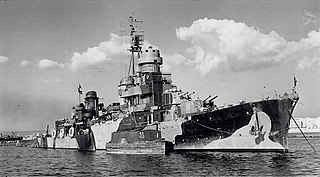
The Capitani Romani class was a class of light cruisers acting as flotilla leaders for the Regia Marina. They were built to outrun and outgun the large new French destroyers of the Le Fantasque and Mogador classes. Twelve hulls were ordered in late 1939, but only four were completed, just three of these before the Italian armistice in 1943. The ships were named after prominent ancient Romans.
Antony Martin Douglas Leslie William Calhoun Preston was an English naval historian and editor, specialising in the area of 19th and 20th-century naval history and warship design.

HMS Swift was a unique destroyer leader designed and built for the Royal Navy prior to World War I, another product of Admiral "Jackie" Fisher's relentless quest for speed. The class was envisioned as a large ocean-going destroyer, capable of both the usual destroyer requirements and of high-speed scouting duties for a major fleet.
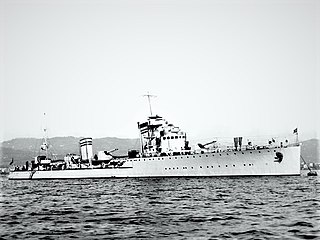
The Navigatori class were a group of Italian destroyers built in 1928–1929 for the Regia Marina, named after Italian explorers. They fought in World War II. Just one vessel, Nicoloso Da Recco, survived the conflict.
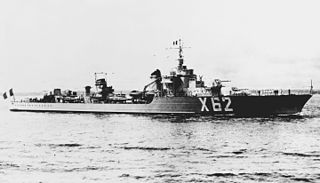
The Mogador-class large destroyers (contre-torpilleurs) of the French Navy were laid down in 1935 and commissioned in 1939. They were extremely fast, very large destroyers intended to act as scouts for the two fast Dunkerque-class battleships. The design evolved from the extremely fast Le Fantasque class, being 300 tons heavier and carrying eight guns in semi-enclosed twin turrets rather than five guns in single open mounts. With their eight 138.6 mm (5.46 in) guns they approached a light cruiser in firepower.
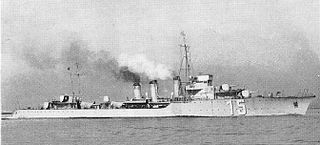
The Bourrasque class was a group of twelve French Navy destroyers (torpilleur) laid down in 1923 and in service from 1926 to 1950. Along with the heavier Chacal class, they were part of a plan to modernise the French fleet after the First World War. The Bourrasques were smaller and slower than the Chacals, but were nonetheless comparable with the British W class. The class saw varied service in the Second World War, in five different navies, on both sides. These ships were named after types of wind.
The Le Hardi class consisted of twelve destroyers built for the Marine Nationale during the late 1930s. Only seven ships were ultimately completed while construction of the remaining five ships was interrupted by the French defeat in the Battle of France in May–June 1940 and were never finished. The seven ships that were seaworthy sailed for French North Africa to prevent their capture by the advancing Germans. Several ships later sailed for French West Africa where Le Hardi played a minor role in the Battle of Dakar in September. The Germans captured two ships that were still under construction and attempted to finish them both before abandoning the effort in 1943.

Nicoloso da Recco was one of a dozen Navigatori-class destroyers built for the Regia Marina in 1930. Named after the Italian Renaissance seaman Nicoloso da Recco, she served during World War II in which she was the sole survivor of her destroyer class. She shot down three Beaufort bombers while escorting a two-freighter convoy on 21 June 1942 off Tunisia. On 2 December 1942 Nicoloso Da Recco took part of the Battle of Skerki Bank, where an Italo-German convoy carrying troops and supplies to Libya was obliterated by Allied naval forces. Nicoloso Da Recco was the only vessel of her class to survive the war, and was eventually scrapped in July 1954.

Chevalier Paul was one of six Vauquelin-class large destroyers built for the French Navy during the 1930s. The ship entered service in 1934 and spent most of her career in the Mediterranean. During the Spanish Civil War of 1936–1939, she was one of the ships that helped to enforce the non-intervention agreement. When France declared war on Germany in September 1939, all of the Vauquelins were assigned to the High Sea Forces which was tasked to escort French convoys and support the other commands as needed. Chevalier Paul was briefly deployed to Scotland in early 1940 to support the Allied forces in the Norwegian Campaign, but returned to the Mediterranean in time to participate in Operation Vado, a bombardment of Italian coastal facilities after Italy entered the war in June.

Leone Pancaldo was one of twelve Navigatori-class destroyers built for the Regia Marina between the late 1920s. Shortly after Italy's entry into World War II in June 1940, she was sunk by British torpedo bombers in Augusta, Sicily, but was later refloated and repaired. She was briefly used in fast troop transport missions to Tunisia until her second and final sinking by Allied aircraft in April 1943.

The Canon de 37 mm Modèle 1925 was a widely used family of French anti-aircraft guns used by the French Navy during World War II.

Nicolò Zeno was one of a dozen Navigatori-class destroyers built for the Regia Marina in the late 1920s. Completed in 1930, she served in World War II.

Antoniotto Usodimare was one of a dozen Navigatori-class destroyers built for the Regia Marina in the late 1920s. Completed in 1929, she served in World War II.

Emanuele Pessagno was one of a dozen Navigatori-class destroyers built for the Regia Marina in the late 1920s. Completed in 1930, she served in World War II.
Lanzerotto Malocello was one of a dozen Navigatori-class destroyers built for the Regia Marina in the late 1920s. Completed in 1930, she served in World War II.
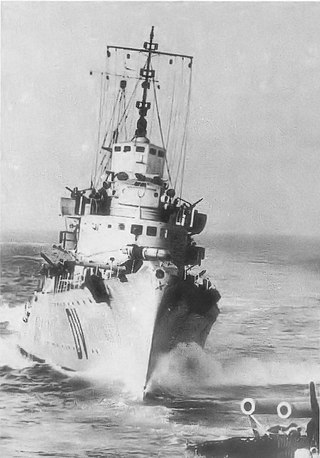
Giovanni da Verazzano was one of a dozen Navigatori-class destroyers built for the Regia Marina in the late 1920s. Completed in 1930, she served in World War II.

Antonio da Noli was one of a dozen Navigatori-class destroyers built for the Regia Marina in the late 1920s. Completed in 1931, she served in World War II.